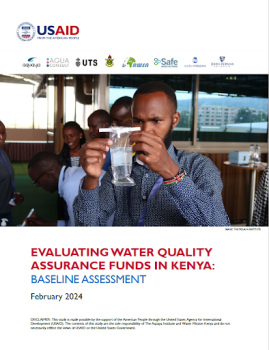Study Rationale
In rural Africa, over two-thirds of the population is estimated to consume contaminated drinking water. Monitoring water quality is essential to providing safe water and protecting public health, yet many rural water suppliers fail to conduct water quality tests regularly. Using an existing centralized laboratory for analysis may be a cost-effective option for expanding testing for many rural water suppliers, but these laboratories may be unwilling to work with rural suppliers due to non-payment risks. The Water Quality Assurance Fund is an innovative program with a financial mechanism developed to address these issues and encourage water quality monitoring in rural areas of Ghana, Kenya, and similar countries. A previous pilot within one district in Ghana found promising results, but a larger, rigorous evaluation trial is necessary to evaluate the impacts and quantify the cost-effectiveness of the Assurance Fund program.
Study Design
This report, produced by USAID/REAL-Water, summarizes baseline data collected in Kenya prior to the launch of a two-year impact evaluation of the Assurance Fund implementation model. This evaluation consists of a randomized stepped-wedge trial, which allows for measuring impacts rigorously while rolling out the intervention gradually. The evaluation in Kenya includes 32 piped water systems randomly assigned to one of three groups successively entering the Assurance Fund program at six-month intervals. At baseline, REAL-WATER measured the same indicators that it will measure subsequently over the course of the stepped-wedge trial: chlorine residual and E. coli concentrations in water samples (the primary outcome indicators for the trial); water treatment practices; water quality knowledge of water system operators and local government officials; consumer awareness of and perceptions of water safety; and consumer willingness-to-pay for increased water treatment and testing. REAL-WATER is also evaluating the effects of the Assurance Fund program in Ghana using a similar stepped-wedge randomized trial with 21 randomly assigned water systems.
Summary of Findings
The baseline results identified several areas of improvement in water safety management that the Water Quality Assurance Fund program may address:
- WATER QUALITY KNOWLEDGE: Water system operators and area managers had some knowledge of sources of contamination; what makes water safe, including chlorination; and regulations and standards related to water quality. However, they had little knowledge about types of contaminants or pathogenic microorganisms. These findings suggest that monthly water quality testing and debrief meetings may improve water quality knowledge among water system operators and decision makers. We hypothesize that improved knowledge could lead to better water treatment, system management, and source protection practices.
- WATER TREATMENT: Most water samples had chlorine concentrations below the recommended level of at least 0.2 mg/L free chlorine residual (90 percent of water samples), providing insufficient treatment or protection against recontamination during transport and storage. Microbial water quality was sometimes good at the point of collection (45 percent of standpipes and private taps had no E. coli in 100-ml water samples), but often poor at the point of use (E. coli was present in 70 percent of stored household water samples). These findings indicate that the information from monthly water quality test results and technical guidance on remedial actions may encourage water operators to improve their water treatment practices. We hypothesize that there will be improvements in chlorine residual and reductions in E. coli at the point of collection due to these activities.
- COMMUNICATION AND CONSUMER PERCEPTIONS: Water providers rarely communicated water quality information with communities. Regular community engagement activities may improve community members’ awareness of water quality testing, treatment practices, and water safety levels. We hypothesize that with adequate community engagement, water systems will be able to increase their tariffs to fund improvements in water safety management.


